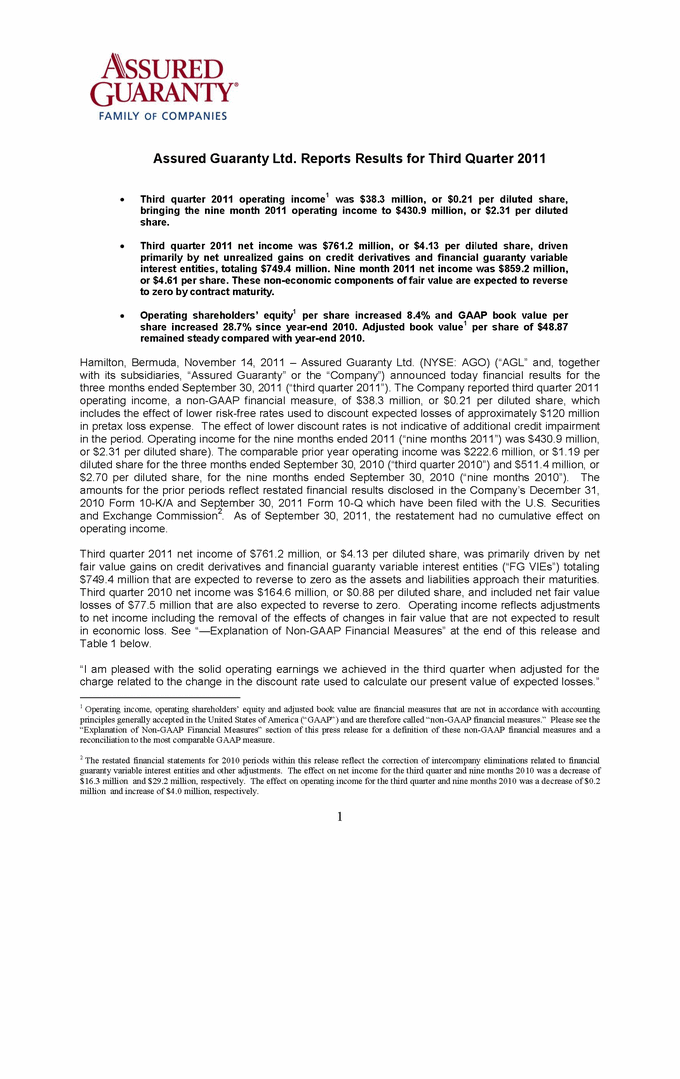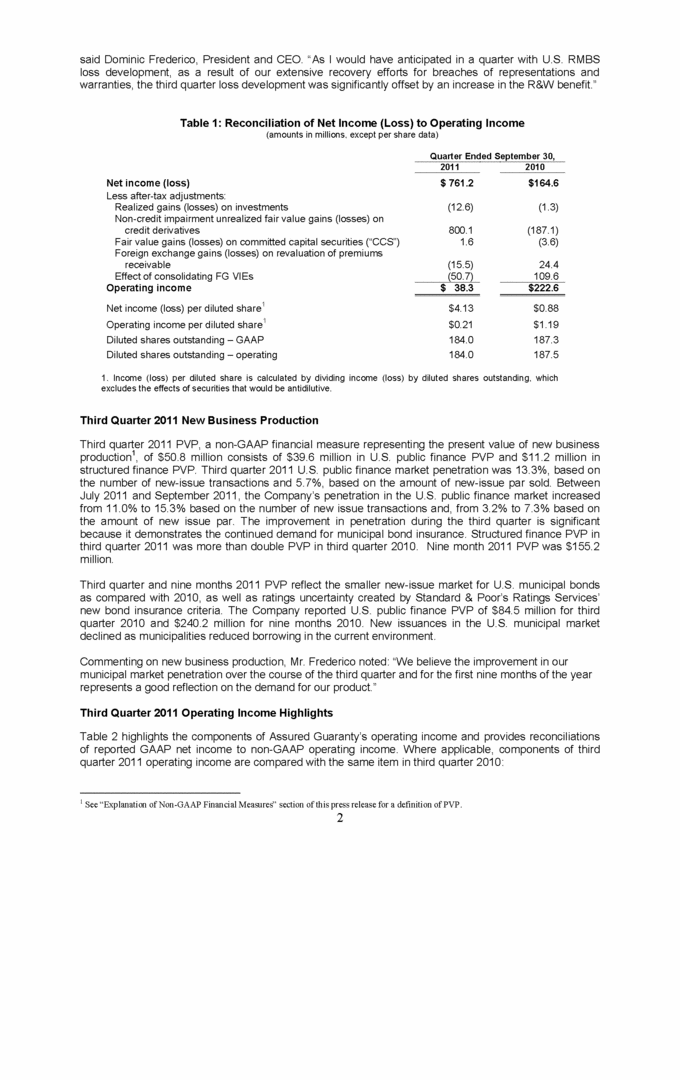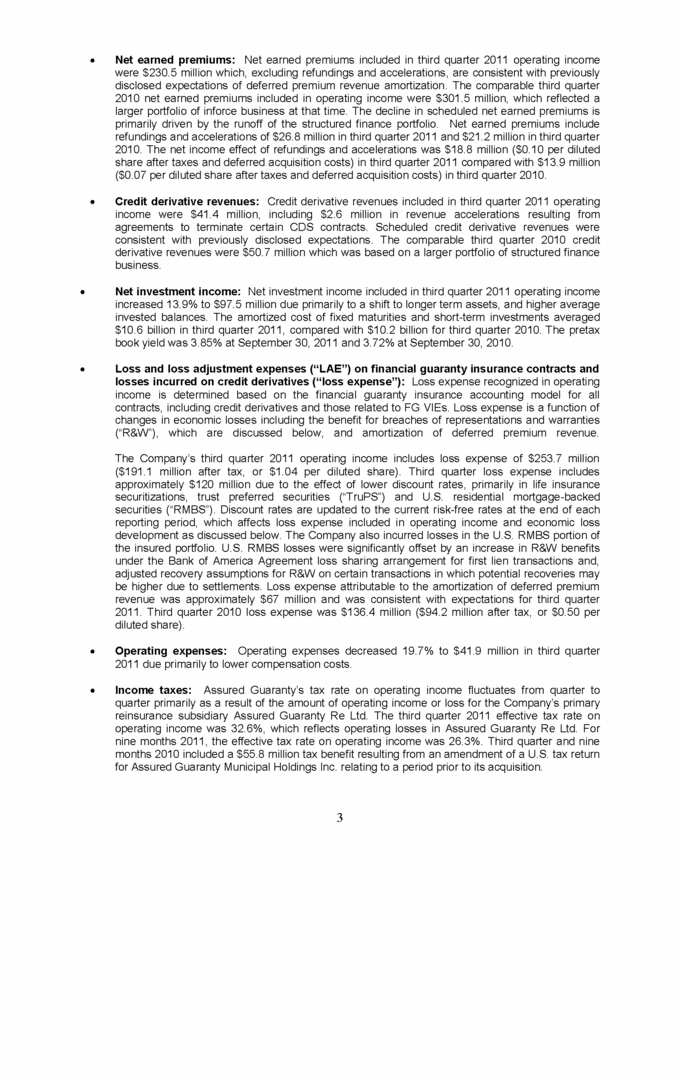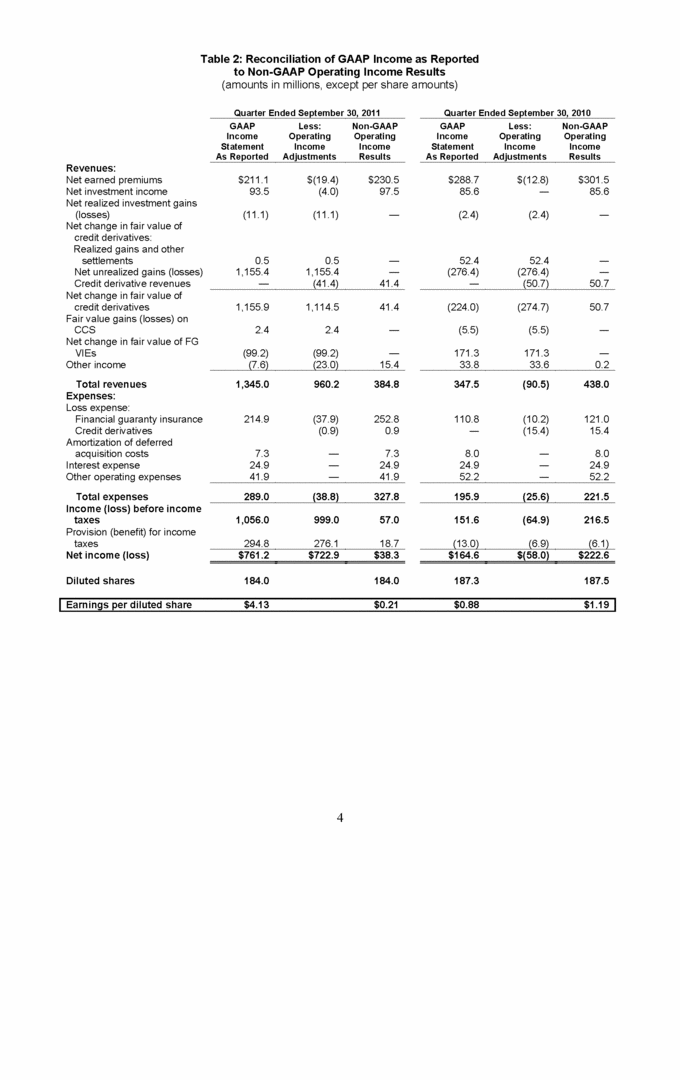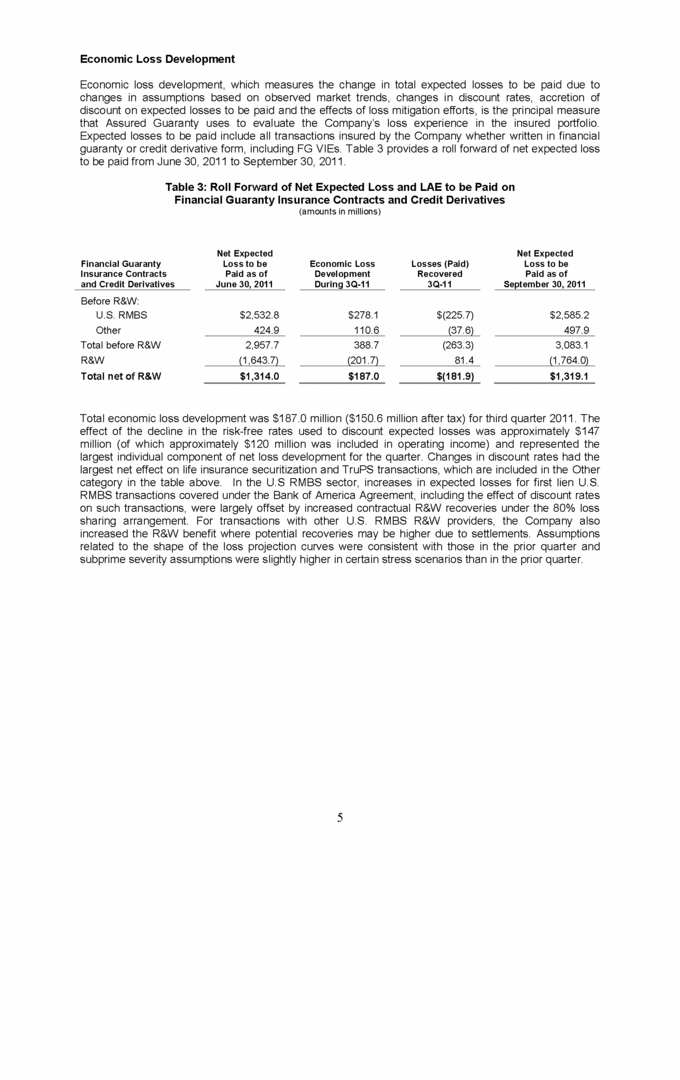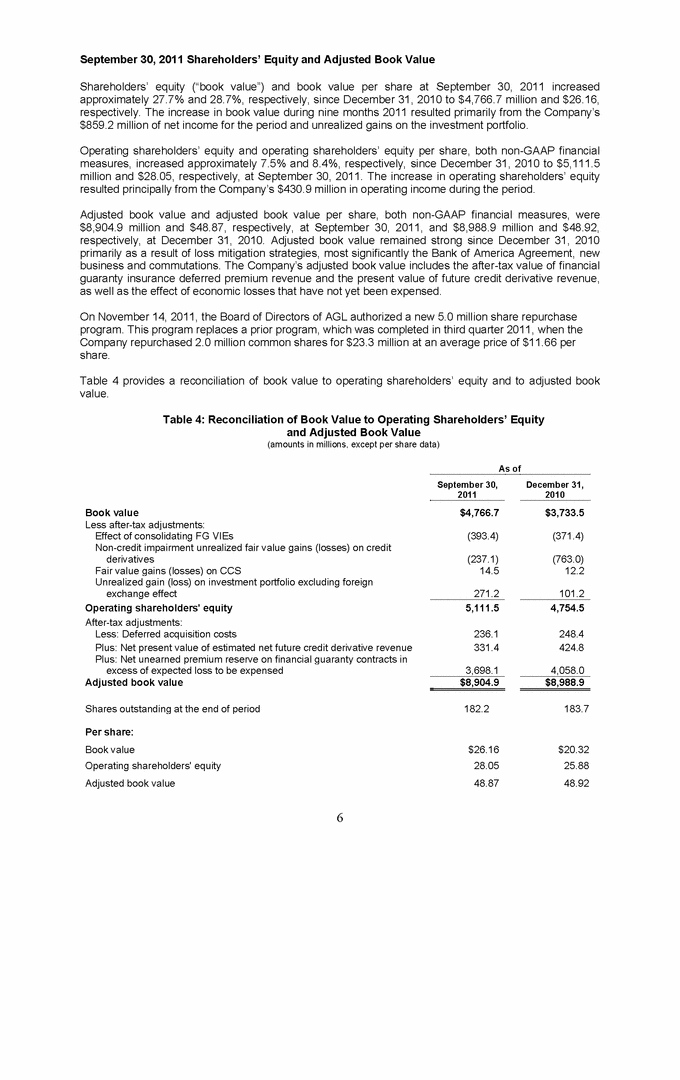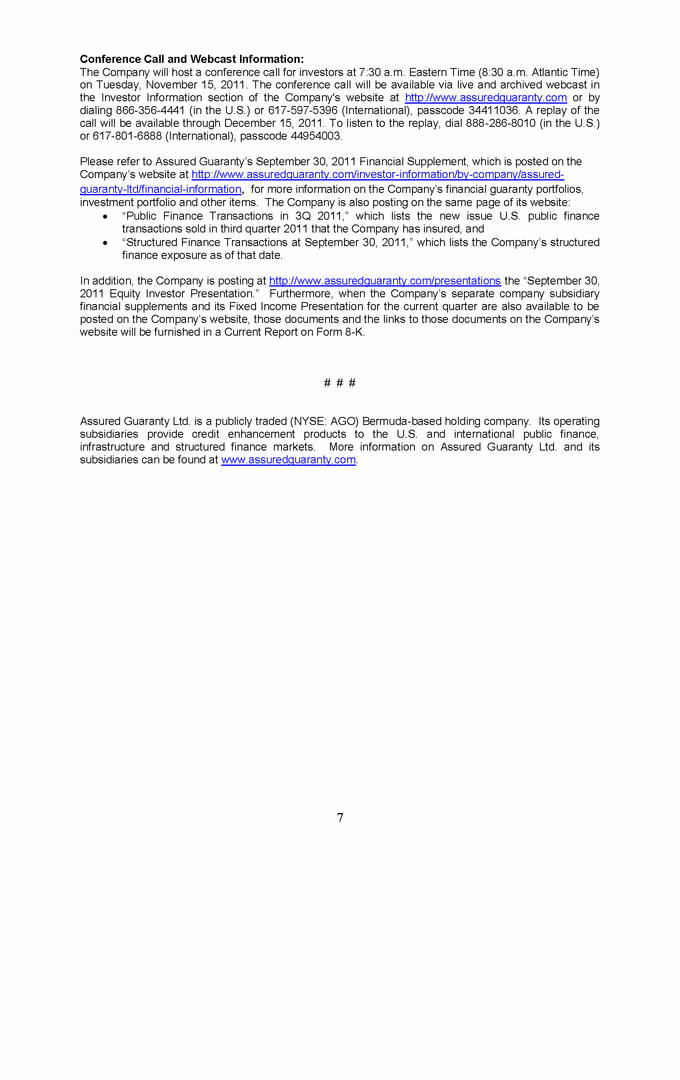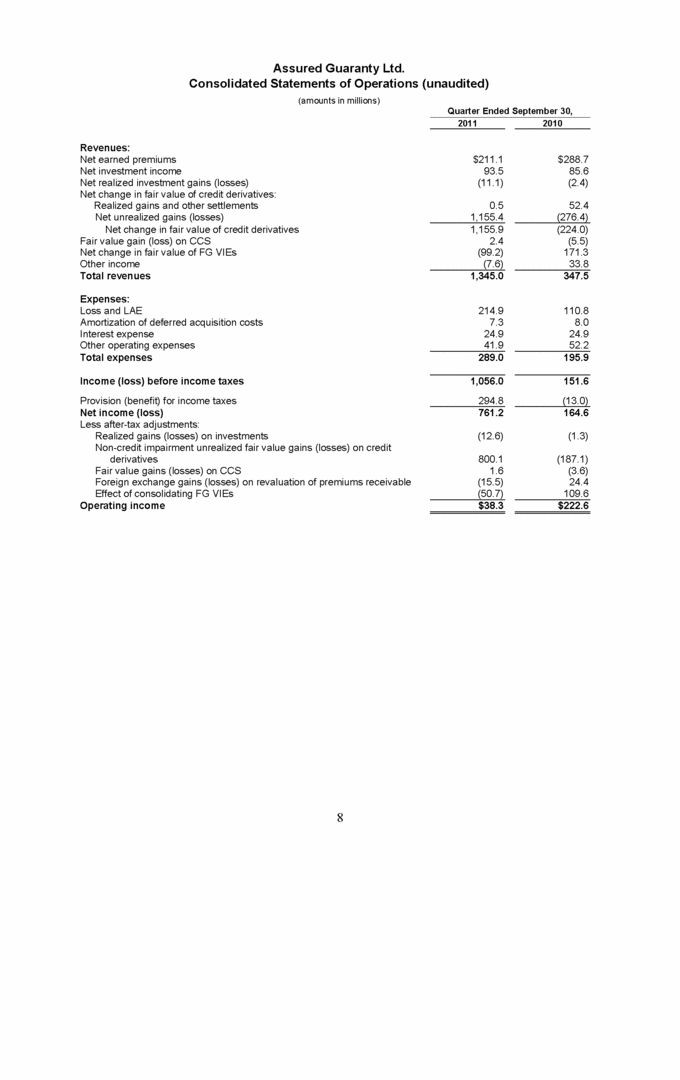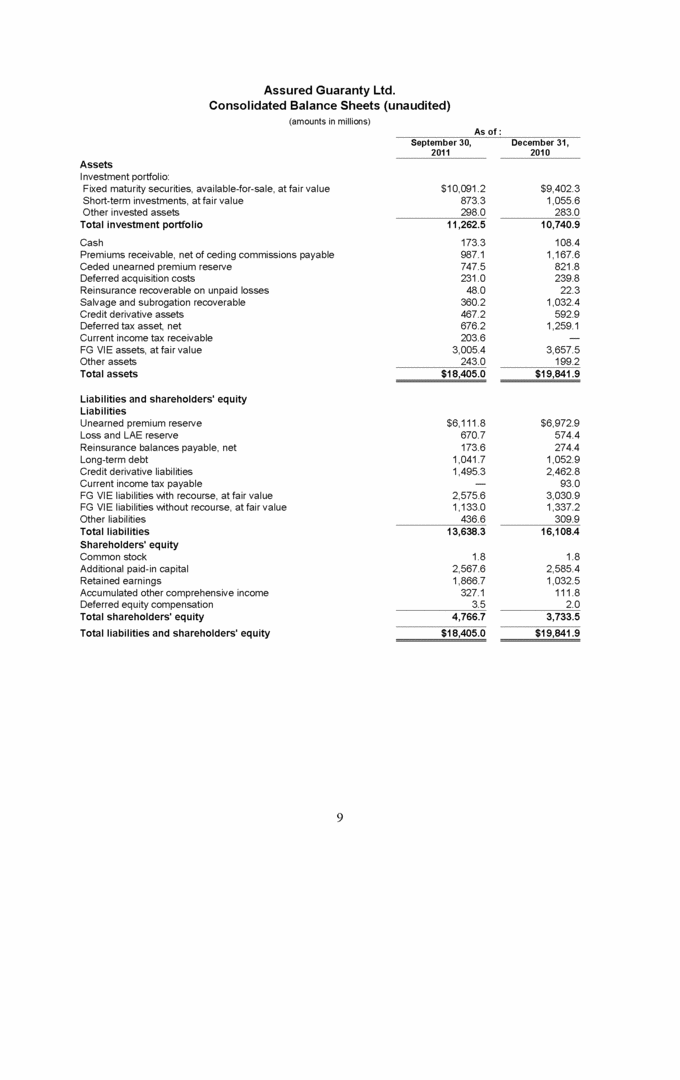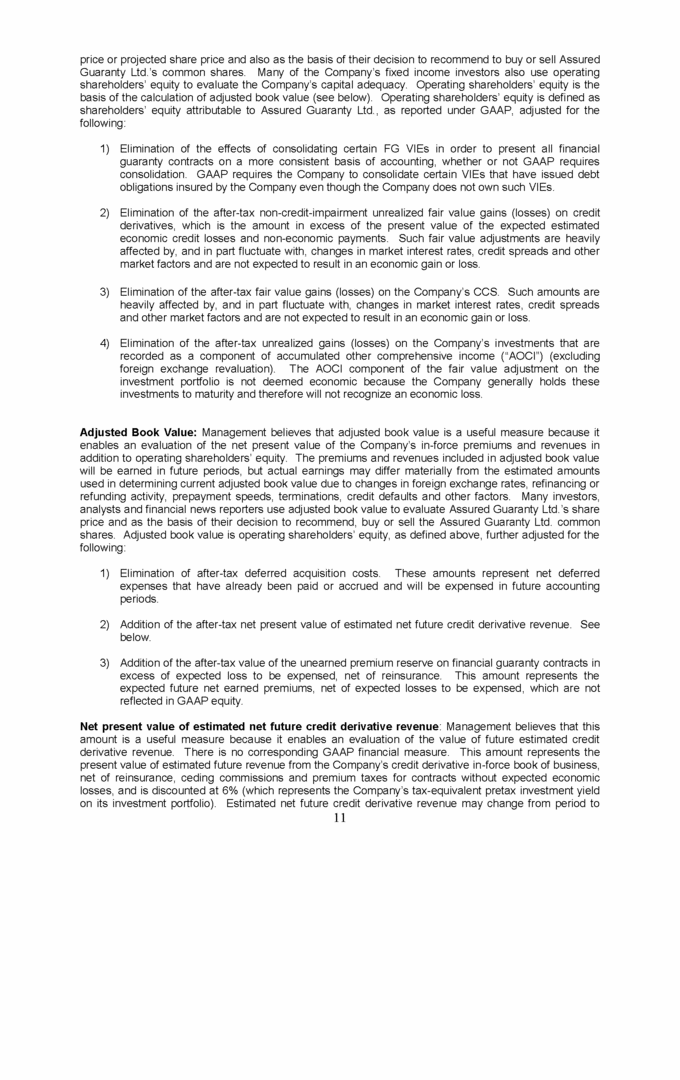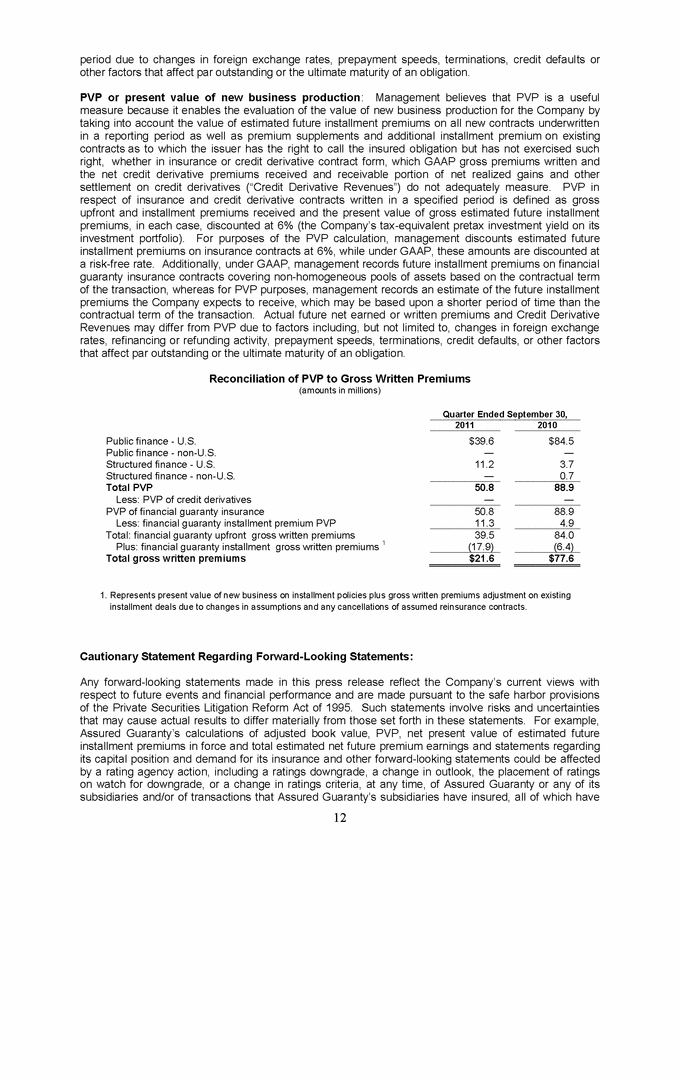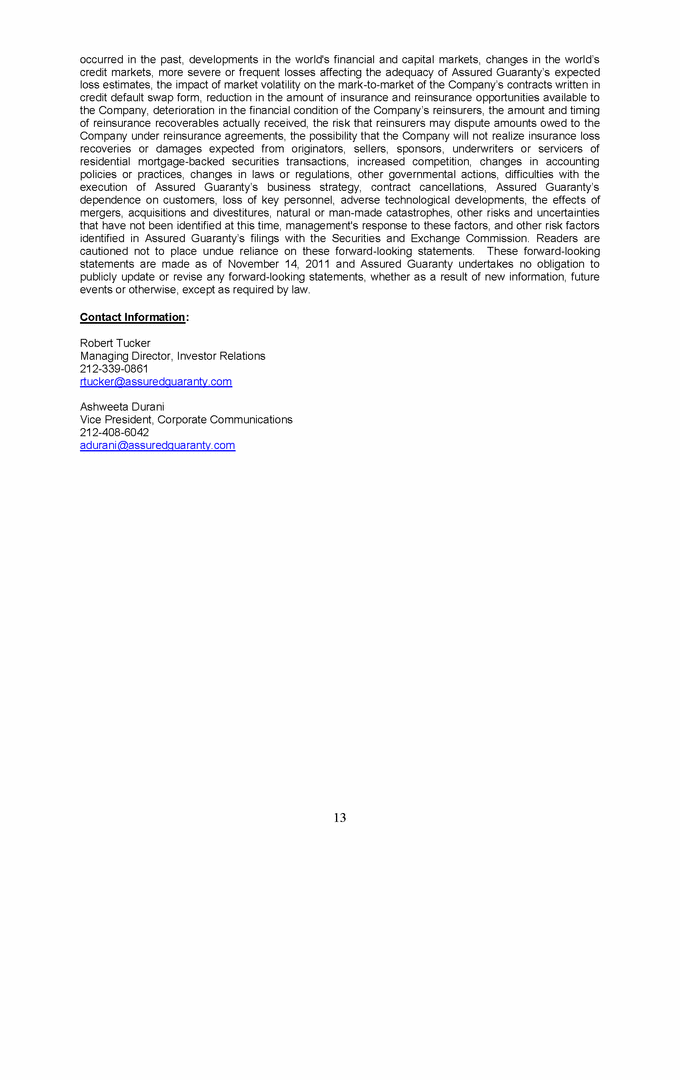Attached files
| file | filename |
|---|---|
| EX-99.2 - EX-99.2 - ASSURED GUARANTY LTD | a11-29826_1ex99d2.htm |
| 8-K - 8-K - ASSURED GUARANTY LTD | a11-29826_18k.htm |
Exhibit 99.1
|
|
Assured Guaranty Ltd. Reports Results for Third Quarter 2011 Third quarter 2011 operating income1 was $38.3 million, or $0.21 per diluted share, bringing the nine month 2011 operating income to $430.9 million, or $2.31 per diluted share. Third quarter 2011 net income was $761.2 million, or $4.13 per diluted share, driven primarily by net unrealized gains on credit derivatives and financial guaranty variable interest entities, totaling $749.4 million. Nine month 2011 net income was $859.2 million, or $4.61 per share. These non-economic components of fair value are expected to reverse to zero by contract maturity. Operating shareholders’ equity1 per share increased 8.4% and GAAP book value per share increased 28.7% since year-end 2010. Adjusted book value1 per share of $48.87 remained steady compared with year-end 2010. Hamilton, Bermuda, November 14, 2011 — Assured Guaranty Ltd. (NYSE: AGO) (“AGL” and, together with its subsidiaries, “Assured Guaranty” or the “Company”) announced today financial results for the three months ended September 30, 2011 (“third quarter 2011”). The Company reported third quarter 2011 operating income, a non-GAAP financial measure, of $38.3 million, or $0.21 per diluted share, which includes the effect of lower risk-free rates used to discount expected losses of approximately $120 million in pretax loss expense. The effect of lower discount rates is not indicative of additional credit impairment in the period. Operating income for the nine months ended 2011 (“nine months 2011”) was $430.9 million, or $2.31 per diluted share). The comparable prior year operating income was $222.6 million, or $1.19 per diluted share for the three months ended September 30, 2010 (“third quarter 2010”) and $511.4 million, or $2.70 per diluted share, for the nine months ended September 30, 2010 (“nine months 2010”). The amounts for the prior periods reflect restated financial results disclosed in the Company’s December 31, 2010 Form 10-K/A and September 30, 2011 Form 10-Q which have been filed with the U.S. Securities and Exchange Commission2. As of September 30, 2011, the restatement had no cumulative effect on operating income. Third quarter 2011 net income of $761.2 million, or $4.13 per diluted share, was primarily driven by net fair value gains on credit derivatives and financial guaranty variable interest entities (“FG VIEs”) totaling $749.4 million that are expected to reverse to zero as the assets and liabilities approach their maturities. Third quarter 2010 net income was $164.6 million, or $0.88 per diluted share, and included net fair value losses of $77.5 million that are also expected to reverse to zero. Operating income reflects adjustments to net income including the removal of the effects of changes in fair value that are not expected to result in economic loss. See “—Explanation of Non-GAAP Financial Measures” at the end of this release and Table 1 below. “I am pleased with the solid operating earnings we achieved in the third quarter when adjusted for the charge related to the change in the discount rate used to calculate our present value of expected losses.” 1 Operating income, operating shareholders’ equity and adjusted book value are financial measures that are not in accordance with accounting principles generally accepted in the United States of America (“GAAP”) and are therefore called “non-GAAP financial measures.” Please see the “Explanation of Non-GAAP Financial Measures” section of this press release for a definition of these non-GAAP financial measures and a reconciliation to the most comparable GAAP measure. 2 The restated financial statements for 2010 periods within this release reflect the correction of intercompany eliminations related to financial guaranty variable interest entities and other adjustments. The effect on net income for the third quarter and nine months 2010 was a decrease of $16.3 million and $29.2 million, respectively. The effect on operating income for the third quarter and nine months 2010 was a decrease of $0.2 million and increase of $4.0 million, respectively. 1 |
|
|
said Dominic Frederico, President and CEO. “As I would have anticipated in a quarter with U.S. RMBS loss development, as a result of our extensive recovery efforts for breaches of representations and warranties, the third quarter loss development was significantly offset by an increase in the R&W benefit.” Table 1: Reconciliation of Net Income (Loss) to Operating Income (amounts in millions, except per share data) Quarter Ended September 30, 2011 2010 Net income (loss) $761.2 $164.6 Less after-tax adjustments: Realized gains (losses) on investments (12.6) (1.3) Non-credit impairment unrealized fair value gains (losses) on credit derivatives 800.1 (187.1) Fair value gains (losses) on committed capital securities (“CCS”) 1.6 (3.6) Foreign exchange gains (losses) on revaluation of premiums receivable (15.5) 24.4 Effect of consolidating FG VIEs (50.7) 109.6 Operating income $38.3 $222.6 Net income (loss) per diluted share1 $4.13 $0.88 Operating income per diluted share1 $0.21 $1.19 Diluted shares outstanding — GAAP 184.0 187.3 Diluted shares outstanding — operating 184.0 187.5 1. 1. Income (loss) per diluted share is calculated by dividing income (loss) by diluted shares outstanding, which excludes the effects of securities that would be antidilutive. Third Quarter 2011 New Business Production Third quarter 2011 PVP, a non-GAAP financial measure representing the present value of new business production1, of $50.8 million consists of $39.6 million in U.S. public finance PVP and $11.2 million in structured finance PVP. Third quarter 2011 U.S. public finance market penetration was 13.3%, based on the number of new-issue transactions and 5.7%, based on the amount of new-issue par sold. Between July 2011 and September 2011, the Company’s penetration in the U.S. public finance market increased from 11.0% to 15.3% based on the number of new issue transactions and, from 3.2% to 7.3% based on the amount of new issue par. The improvement in penetration during the third quarter is significant because it demonstrates the continued demand for municipal bond insurance. Structured finance PVP in third quarter 2011 was more than double PVP in third quarter 2010. Nine month 2011 PVP was $155.2 million. Third quarter and nine months 2011 PVP reflect the smaller new-issue market for U.S. municipal bonds as compared with 2010, as well as ratings uncertainty created by Standard & Poor’s Ratings Services’ new bond insurance criteria. The Company reported U.S. public finance PVP of $84.5 million for third quarter 2010 and $240.2 million for nine months 2010. New issuances in the U.S. municipal market declined as municipalities reduced borrowing in the current environment. Commenting on new business production, Mr. Frederico noted: “We believe the improvement in our municipal market penetration over the course of the third quarter and for the first nine months of the year represents a good reflection on the demand for our product.” Third Quarter 2011 Operating Income Highlights Table 2 highlights the components of Assured Guaranty’s operating income and provides reconciliations of reported GAAP net income to non-GAAP operating income. Where applicable, components of third quarter 2011 operating income are compared with the same item in third quarter 2010: 1 See “Explanation of Non-GAAP Financial Measures” section of this press release for a definition of PVP. 2 |
|
|
Net earned premiums: Net earned premiums included in third quarter 2011 operating income were $230.5 million which, excluding refundings and accelerations, are consistent with previously disclosed expectations of deferred premium revenue amortization. The comparable third quarter 2010 net earned premiums included in operating income were $301.5 million, which reflected a larger portfolio of inforce business at that time. The decline in scheduled net earned premiums is primarily driven by the runoff of the structured finance portfolio. Net earned premiums include refundings and accelerations of $26.8 million in third quarter 2011 and $21.2 million in third quarter 2010. The net income effect of refundings and accelerations was $18.8 million ($0.10 per diluted share after taxes and deferred acquisition costs) in third quarter 2011 compared with $13.9 million ($0.07 per diluted share after taxes and deferred acquisition costs) in third quarter 2010. Credit derivative revenues: Credit derivative revenues included in third quarter 2011 operating income were $41.4 million, including $2.6 million in revenue accelerations resulting from agreements to terminate certain CDS contracts. Scheduled credit derivative revenues were consistent with previously disclosed expectations. The comparable third quarter 2010 credit derivative revenues were $50.7 million which was based on a larger portfolio of structured finance business. Net investment income: Net investment income included in third quarter 2011 operating income increased 13.9% to $97.5 million due primarily to a shift to longer term assets, and higher average invested balances. The amortized cost of fixed maturities and short-term investments averaged $10.6 billion in third quarter 2011, compared with $10.2 billion for third quarter 2010. The pretax book yield was 3.85% at September 30, 2011 and 3.72% at September 30, 2010. Loss and loss adjustment expenses (“LAE”) on financial guaranty insurance contracts and losses incurred on credit derivatives (“loss expense”): Loss expense recognized in operating income is determined based on the financial guaranty insurance accounting model for all contracts, including credit derivatives and those related to FG VIEs. Loss expense is a function of changes in economic losses including the benefit for breaches of representations and warranties (“R&W”), which are discussed below, and amortization of deferred premium revenue. The Company’s third quarter 2011 operating income includes loss expense of $253.7 million ($191.1 million after tax, or $1.04 per diluted share). Third quarter loss expense includes approximately $120 million due to the effect of lower discount rates, primarily in life insurance securitizations, trust preferred securities (“TruPS”) and U.S. residential mortgage-backed securities (“RMBS”). Discount rates are updated to the current risk-free rates at the end of each reporting period, which affects loss expense included in operating income and economic loss development as discussed below. The Company also incurred losses in the U.S. RMBS portion of the insured portfolio. U.S. RMBS losses were significantly offset by an increase in R&W benefits under the Bank of America Agreement loss sharing arrangement for first lien transactions and, adjusted recovery assumptions for R&W on certain transactions in which potential recoveries may be higher due to settlements. Loss expense attributable to the amortization of deferred premium revenue was approximately $67 million and was consistent with expectations for third quarter 2011. Third quarter 2010 loss expense was $136.4 million ($94.2 million after tax, or $0.50 per diluted share). Operating expenses: Operating expenses decreased 19.7% to $41.9 million in third quarter 2011 due primarily to lower compensation costs. Income taxes: Assured Guaranty’s tax rate on operating income fluctuates from quarter to quarter primarily as a result of the amount of operating income or loss for the Company’s primary reinsurance subsidiary Assured Guaranty Re Ltd. The third quarter 2011 effective tax rate on operating income was 32.6%, which reflects operating losses in Assured Guaranty Re Ltd. For nine months 2011, the effective tax rate on operating income was 26.3%. Third quarter and nine months 2010 included a $55.8 million tax benefit resulting from an amendment of a U.S. tax return for Assured Guaranty Municipal Holdings Inc. relating to a period prior to its acquisition. 3 |
|
|
Table 2: Reconciliation of GAAP Income as Reported to Non-GAAP Operating Income Results (amounts in millions, except per share amounts) Quarter Ended September 30, 2011 Quarter Ended September 30, 2010 GAAP Income Statement As Reported Less: Operating Income Adjustments Non-GAAP Operating Income Results GAAP Income Statement As Reported Less: Operating Income Adjustments Non-GAAP Operating Income Results Revenues: Net earned premiums $211.1 $(19.4) $230.5 $288.7 $(12.8) $301.5 Net investment income 93.5 (4.0) 97.5 85.6 — 85.6 Net realized investment gains (losses) (11.1) (11.1) — (2.4) (2.4) — Net change in fair value of credit derivatives: Realized gains and other settlements 0.5 0.5 — 52.4 52.4 — Net unrealized gains (losses) 1,155.4 1,155.4 — (276.4) (276.4) — Credit derivative revenues — (41.4) 41.4 — (50.7) 50.7 Net change in fair value of credit derivatives 1,155.9 1,114.5 41.4 (224.0) (274.7) 50.7 Fair value gains (losses) on CCS 2.4 2.4 — (5.5) (5.5) — Net change in fair value of FG VIEs (99.2) (99.2) — 171.3 171.3 — Other income (7.6) (23.0) 15.4 33.8 33.6 0.2 Total revenues 1,345.0 960.2 384.8 347.5 (90.5) 438.0 Expenses: Loss expense: Financial guaranty insurance 214.9 (37.9) 252.8 110.8 (10.2) 121.0 Credit derivatives (0.9) 0.9 — (15.4) 15.4 Amortization of deferred acquisition costs 7.3 — 7.3 8.0 — 8.0 Interest expense 24.9 — 24.9 24.9 — 24.9 Other operating expenses 41.9 — 41.9 52.2 — 52.2 Total expenses 289.0 (38.8) 327.8 195.9 (25.6) 221.5 Income (loss) before income taxes 1,056.0 999.0 57.0 151.6 (64.9) 216.5 Provision (benefit) for income taxes 294.8 276.1 18.7 (13.0) (6.9) (6.1) Net income (loss) $761.2 $722.9 $38.3 $164.6 $(58.0) $222.6 Diluted shares 184.0 184.0 187.3 187.5 Earnings per diluted share $4.13 $0.21 $0.88 $1.19 4 |
|
|
Economic Loss Development Economic loss development, which measures the change in total expected losses to be paid due to changes in assumptions based on observed market trends, changes in discount rates, accretion of discount on expected losses to be paid and the effects of loss mitigation efforts, is the principal measure that Assured Guaranty uses to evaluate the Company’s loss experience in the insured portfolio. Expected losses to be paid include all transactions insured by the Company whether written in financial guaranty or credit derivative form, including FG VIEs. Table 3 provides a roll forward of net expected loss to be paid from June 30, 2011 to September 30, 2011. Table 3: Roll Forward of Net Expected Loss and LAE to be Paid on Financial Guaranty Insurance Contracts and Credit Derivatives (amounts in millions) Financial Guaranty Insurance Contracts and Credit Derivatives Net Expected Loss to be Paid as of June 30, 2011 Economic Loss Development During 3Q-11 Losses (Paid) Recovered 3Q-11 Net Expected Loss to be Paid as of September 30, 2011 Before R&W: U.S. RMBS $2,532.8 $278.1 $(225.7) $2,585.2 Other 424.9 110.6 (37.6) 497.9 Total before R&W 2,957.7 388.7 (263.3) 3,083.1 R&W (1,643.7) (201.7) 81.4 (1,764.0) Total net of R&W $1,314.0 $187.0 $(181.9) $1,319.1 Total economic loss development was $187.0 million ($150.6 million after tax) for third quarter 2011. The effect of the decline in the risk-free rates used to discount expected losses was approximately $147 million (of which approximately $120 million was included in operating income) and represented the largest individual component of net loss development for the quarter. Changes in discount rates had the largest net effect on life insurance securitization and TruPS transactions, which are included in the Other category in the table above. In the U.S RMBS sector, increases in expected losses for first lien U.S. RMBS transactions covered under the Bank of America Agreement, including the effect of discount rates on such transactions, were largely offset by increased contractual R&W recoveries under the 80% loss sharing arrangement. For transactions with other U.S. RMBS R&W providers, the Company also increased the R&W benefit where potential recoveries may be higher due to settlements. Assumptions related to the shape of the loss projection curves were consistent with those in the prior quarter and subprime severity assumptions were slightly higher in certain stress scenarios than in the prior quarter. 5 |
|
|
September 30, 2011 Shareholders’ Equity and Adjusted Book Value Shareholders’ equity (“book value”) and book value per share at September 30, 2011 increased approximately 27.7% and 28.7%, respectively, since December 31, 2010 to $4,766.7 million and $26.16, respectively. The increase in book value during nine months 2011 resulted primarily from the Company’s $859.2 million of net income for the period and unrealized gains on the investment portfolio. Operating shareholders’ equity and operating shareholders’ equity per share, both non-GAAP financial measures, increased approximately 7.5% and 8.4%, respectively, since December 31, 2010 to $5,111.5 million and $28.05, respectively, at September 30, 2011. The increase in operating shareholders’ equity resulted principally from the Company’s $430.9 million in operating income during the period. Adjusted book value and adjusted book value per share, both non-GAAP financial measures, were $8,904.9 million and $48.87, respectively, at September 30, 2011, and $8,988.9 million and $48.92, respectively, at December 31, 2010. Adjusted book value remained strong since December 31, 2010 primarily as a result of loss mitigation strategies, most significantly the Bank of America Agreement, new business and commutations. The Company’s adjusted book value includes the after-tax value of financial guaranty insurance deferred premium revenue and the present value of future credit derivative revenue, as well as the effect of economic losses that have not yet been expensed. On November 14, 2011, the Board of Directors of AGL authorized a new 5.0 million share repurchase program. This program replaces a prior program, which was completed in third quarter 2011, when the Company repurchased 2.0 million common shares for $23.3 million at an average price of $11.66 per share. Table 4 provides a reconciliation of book value to operating shareholders’ equity and to adjusted book value. Table 4: Reconciliation of Book Value to Operating Shareholders’ Equity and Adjusted Book Value (amounts in millions, except per share data) As of September 30, 2011 December 31, 2010 Book value $4,766.7 $3,733.5 Less after-tax adjustments: Effect of consolidating FG VIEs (393.4) (371.4) Non-credit impairment unrealized fair value gains (losses) on credit derivatives (237.1) (763.0) Fair value gains (losses) on CCS 14.5 12.2 Unrealized gain (loss) on investment portfolio excluding foreign exchange effect 271.2 101.2 Operating shareholders’ equity 5,111.5 4,754.5 After-tax adjustments: Less: Deferred acquisition costs 236.1 248.4 Plus: Net present value of estimated net future credit derivative revenue 331.4 424.8 Plus: Net unearned premium reserve on financial guaranty contracts in excess of expected loss to be expensed 3,698.1 4,058.0 Adjusted book value $8,904.9 $8,988.9 Shares outstanding at the end of period 182.2 183.7 Per share: Book value $26.16 $20.32 Operating shareholders’ equity 28.05 25.88 Adjusted book value 48.87 48.92 6 |
|
|
Conference Call and Webcast Information: The Company will host a conference call for investors at 7:30 a.m. Eastern Time (8:30 a.m. Atlantic Time) on Tuesday, November 15, 2011. The conference call will be available via live and archived webcast in the Investor Information section of the Company’s website at http://www.assuredguaranty.com or by dialing 866-356-4441 (in the U.S.) or 617-597-5396 (International), passcode 34411036. A replay of the call will be available through December 15, 2011. To listen to the replay, dial 888-286-8010 (in the U.S.) or 617-801-6888 (International), passcode 44954003. Please refer to Assured Guaranty’s September 30, 2011 Financial Supplement, which is posted on the Company’s website at http://www.assuredguaranty.com/investor-information/by-company/assured-guaranty-ltd/financial-information, for more information on the Company’s financial guaranty portfolios, investment portfolio and other items. The Company is also posting on the same page of its website: “Public Finance Transactions in 3Q 2011,” which lists the new issue U.S. public finance transactions sold in third quarter 2011 that the Company has insured, and “Structured Finance Transactions at September 30, 2011,” which lists the Company’s structured finance exposure as of that date. In addition, the Company is posting at http://www.assuredguaranty.com/presentations the “September 30, 2011 Equity Investor Presentation.” Furthermore, when the Company’s separate company subsidiary financial supplements and its Fixed Income Presentation for the current quarter are also available to be posted on the Company’s website, those documents and the links to those documents on the Company’s website will be furnished in a Current Report on Form 8-K. # # # Assured Guaranty Ltd. is a publicly traded (NYSE: AGO) Bermuda-based holding company. Its operating subsidiaries provide credit enhancement products to the U.S. and international public finance, infrastructure and structured finance markets. More information on Assured Guaranty Ltd. and its subsidiaries can be found at www.assuredguaranty.com. 7 |
|
|
Assured Guaranty Ltd. Consolidated Statements of Operations (unaudited) (amounts in millions) Quarter Ended September 30, 2011 2010 Revenues: Net earned premiums $211.1 $288.7 Net investment income 93.5 85.6 Net realized investment gains (losses) (11.1) (2.4) Net change in fair value of credit derivatives: Realized gains and other settlements 0.5 52.4 Net unrealized gains (losses) 1,155.4 (276.4) Net change in fair value of credit derivatives 1,155.9 (224.0) Fair value gain (loss) on CCS 2.4 (5.5) Net change in fair value of FG VIEs (99.2) 171.3 Other income (7.6) 33.8 Total revenues 1,345.0 347.5 Expenses: Loss and LAE 214.9 110.8 Amortization of deferred acquisition costs 7.3 8.0 Interest expense 24.9 24.9 Other operating expenses 41.9 52.2 Total expenses 289.0 195.9 Income (loss) before income taxes 1,056.0 151.6 Provision (benefit) for income taxes 294.8 (13.0) Net income (loss) 761.2 164.6 Less after-tax adjustments: Realized gains (losses) on investments (12.6) (1.3) Non-credit impairment unrealized fair value gains (losses) on credit derivatives 800.1 (187.1) Fair value gains (losses) on CCS 1.6 (3.6) Foreign exchange gains (losses) on revaluation of premiums receivable (15.5) 24.4 Effect of consolidating FG VIEs (50.7) 109.6 Operating income $38.3 $222.6 8 |
|
|
Assured Guaranty Ltd. Consolidated Balance Sheets (unaudited) (amounts in millions) As of : September 30, 2011 December 31, 2010 Assets Investment portfolio: Fixed maturity securities, available-for-sale, at fair value $10,091.2 $9,402.3 Short-term investments, at fair value 873.3 1,055.6 Other invested assets 298.0 283.0 Total investment portfolio 11,262.5 10,740.9 Cash 173.3 108.4 Premiums receivable, net of ceding commissions payable 987.1 1,167.6 Ceded unearned premium reserve 747.5 821.8 Deferred acquisition costs 231.0 239.8 Reinsurance recoverable on unpaid losses 48.0 22.3 Salvage and subrogation recoverable 360.2 1,032.4 Credit derivative assets 467.2 592.9 Deferred tax asset, net 676.2 1,259.1 Current income tax receivable 203.6 — FG VIE assets, at fair value 3,005.4 3,657.5 Other assets 243.0 199.2 Total assets $18,405.0 $19,841.9 Liabilities and shareholders’ equity Liabilities Unearned premium reserve $6,111.8 $6,972.9 Loss and LAE reserve 670.7 574.4 Reinsurance balances payable, net 173.6 274.4 Long-term debt 1,041.7 1,052.9 Credit derivative liabilities 1,495.3 2,462.8 Current income tax payable — 93.0 FG VIE liabilities with recourse, at fair value 2,575.6 3,030.9 FG VIE liabilities without recourse, at fair value 1,133.0 1,337.2 Other liabilities 436.6 309.9 Total liabilities 13,638.3 16,108.4 Shareholders’ equity Common stock 1.8 1.8 Additional paid-in capital 2,567.6 2,585.4 Retained earnings 1,866.7 1,032.5 Accumulated other comprehensive income 327.1 111.8 Deferred equity compensation 3.5 2.0 Total shareholders’ equity 4,766.7 3,733.5 Total liabilities and shareholders’ equity $18,405.0 $19,841.9 9 |
|
|
Explanation of Non-GAAP Financial Measures: The Company references financial measures that are not in accordance with GAAP. Assured Guaranty’s management and board of directors utilize non-GAAP measures in evaluating the Company’s financial performance and as a basis for determining senior management incentive compensation. By providing these non-GAAP financial measures, investors, analysts and financial news reporters have access to the same information that management reviews internally. In addition, Assured Guaranty’s presentation of non-GAAP financial measures is consistent with how analysts calculate their estimates of Assured Guaranty’s financial results in their research reports on Assured Guaranty and with how investors, analysts and the financial news media evaluate Assured Guaranty’s financial results. The following paragraphs define each non-GAAP financial measure and describe why it is useful. A reconciliation of the non-GAAP financial measure and the most directly comparable GAAP financial measure, if available, is presented above. Non-GAAP financial measures should not be viewed as substitutes for their most directly comparable GAAP measures. Operating Income: Management believes that operating income is a useful measure because it clarifies the understanding of the underwriting results of the Company’s financial guaranty insurance business, and also includes financing costs and net investment income, and enables investors and analysts to evaluate the Company’s financial results as compared with the consensus analyst estimates distributed publicly by financial databases. Operating income is defined as net income (loss) attributable to Assured Guaranty Ltd., as reported under GAAP, adjusted for the following: 1) Elimination of the after-tax realized gains (losses) on the Company’s investments, except for gains and losses on securities classified as trading. The timing of realized gains and losses, which depends largely on market credit cycles, can vary considerably across periods. The timing of sales is largely subject to the Company’s discretion and influenced by market opportunities, as well as the Company’s tax and capital profile. Trends in the underlying profitability of the Company’s business can be more clearly identified without the fluctuating effects of these transactions. 2) Elimination of the after-tax non-credit-impairment unrealized fair value gains (losses) on credit derivatives, which is the amount in excess of the present value of the expected estimated economic credit losses and non-economic payments. Such fair value adjustments are heavily affected by, and in part fluctuate with, changes in market interest rates, credit spreads and other market factors and are not expected to result in an economic gain or loss. Additionally, such adjustments present all financial guaranty contracts on a more consistent basis of accounting, whether or not they are subject to derivative accounting rules. 3) Elimination of the after-tax fair value gains (losses) on the Company’s CCS. Such amounts are heavily affected by, and in part fluctuate with, changes in market interest rates, credit spreads and other market factors and are not expected to result in an economic gain or loss. 4) Elimination of the after-tax foreign exchange gains (losses) on revaluation of net premium receivables. Long-dated receivables constitute a significant portion of the net premium receivable balance and represent the present value of future contractual or expected collections. Therefore, the current period’s foreign exchange revaluation gains (losses) are not necessarily indicative of the total foreign exchange gains (losses) that the Company will ultimately recognize. 5) Elimination of the effects of consolidating certain FG VIEs in order to present all financial guaranty contracts on a more consistent basis of accounting, whether or not GAAP requires consolidation. GAAP requires the Company to consolidate certain VIEs that have issued debt obligations insured by the Company even though the Company does not own such VIEs. Operating Shareholders’ Equity: Management believes that operating shareholders’ equity is a useful measure because it presents the equity of Assured Guaranty Ltd. with all financial guaranty contracts accounted for on a more consistent basis and excludes fair value adjustments that are not expected to result in economic loss. Many investors, analysts and financial news reporters use operating shareholders’ equity as the principal financial measure for valuing Assured Guaranty Ltd.’s current share 10 |
|
|
price or projected share price and also as the basis of their decision to recommend to buy or sell Assured Guaranty Ltd.’s common shares. Many of the Company’s fixed income investors also use operating shareholders’ equity to evaluate the Company’s capital adequacy. Operating shareholders’ equity is the basis of the calculation of adjusted book value (see below). Operating shareholders’ equity is defined as shareholders’ equity attributable to Assured Guaranty Ltd., as reported under GAAP, adjusted for the following: 1) Elimination of the effects of consolidating certain FG VIEs in order to present all financial guaranty contracts on a more consistent basis of accounting, whether or not GAAP requires consolidation. GAAP requires the Company to consolidate certain VIEs that have issued debt obligations insured by the Company even though the Company does not own such VIEs. 2) Elimination of the after-tax non-credit-impairment unrealized fair value gains (losses) on credit derivatives, which is the amount in excess of the present value of the expected estimated economic credit losses and non-economic payments. Such fair value adjustments are heavily affected by, and in part fluctuate with, changes in market interest rates, credit spreads and other market factors and are not expected to result in an economic gain or loss. 3) Elimination of the after-tax fair value gains (losses) on the Company’s CCS. Such amounts are heavily affected by, and in part fluctuate with, changes in market interest rates, credit spreads and other market factors and are not expected to result in an economic gain or loss. 4) Elimination of the after-tax unrealized gains (losses) on the Company’s investments that are recorded as a component of accumulated other comprehensive income (“AOCI”) (excluding foreign exchange revaluation). The AOCI component of the fair value adjustment on the investment portfolio is not deemed economic because the Company generally holds these investments to maturity and therefore will not recognize an economic loss. Adjusted Book Value: Management believes that adjusted book value is a useful measure because it enables an evaluation of the net present value of the Company’s in-force premiums and revenues in addition to operating shareholders’ equity. The premiums and revenues included in adjusted book value will be earned in future periods, but actual earnings may differ materially from the estimated amounts used in determining current adjusted book value due to changes in foreign exchange rates, refinancing or refunding activity, prepayment speeds, terminations, credit defaults and other factors. Many investors, analysts and financial news reporters use adjusted book value to evaluate Assured Guaranty Ltd.’s share price and as the basis of their decision to recommend, buy or sell the Assured Guaranty Ltd. common shares. Adjusted book value is operating shareholders’ equity, as defined above, further adjusted for the following: 1) Elimination of after-tax deferred acquisition costs. These amounts represent net deferred expenses that have already been paid or accrued and will be expensed in future accounting periods. 2) Addition of the after-tax net present value of estimated net future credit derivative revenue. See below. 3) Addition of the after-tax value of the unearned premium reserve on financial guaranty contracts in excess of expected loss to be expensed, net of reinsurance. This amount represents the expected future net earned premiums, net of expected losses to be expensed, which are not reflected in GAAP equity. Net present value of estimated net future credit derivative revenue: Management believes that this amount is a useful measure because it enables an evaluation of the value of future estimated credit derivative revenue. There is no corresponding GAAP financial measure. This amount represents the present value of estimated future revenue from the Company’s credit derivative in-force book of business, net of reinsurance, ceding commissions and premium taxes for contracts without expected economic losses, and is discounted at 6% (which represents the Company’s tax-equivalent pretax investment yield on its investment portfolio). Estimated net future credit derivative revenue may change from period to 11 |
|
|
period due to changes in foreign exchange rates, prepayment speeds, terminations, credit defaults or other factors that affect par outstanding or the ultimate maturity of an obligation. PVP or present value of new business production: Management believes that PVP is a useful measure because it enables the evaluation of the value of new business production for the Company by taking into account the value of estimated future installment premiums on all new contracts underwritten in a reporting period as well as premium supplements and additional installment premium on existing contracts as to which the issuer has the right to call the insured obligation but has not exercised such right, whether in insurance or credit derivative contract form, which GAAP gross premiums written and the net credit derivative premiums received and receivable portion of net realized gains and other settlement on credit derivatives (“Credit Derivative Revenues”) do not adequately measure. PVP in respect of insurance and credit derivative contracts written in a specified period is defined as gross upfront and installment premiums received and the present value of gross estimated future installment premiums, in each case, discounted at 6% (the Company’s tax-equivalent pretax investment yield on its investment portfolio). For purposes of the PVP calculation, management discounts estimated future installment premiums on insurance contracts at 6%, while under GAAP, these amounts are discounted at a risk-free rate. Additionally, under GAAP, management records future installment premiums on financial guaranty insurance contracts covering non-homogeneous pools of assets based on the contractual term of the transaction, whereas for PVP purposes, management records an estimate of the future installment premiums the Company expects to receive, which may be based upon a shorter period of time than the contractual term of the transaction. Actual future net earned or written premiums and Credit Derivative Revenues may differ from PVP due to factors including, but not limited to, changes in foreign exchange rates, refinancing or refunding activity, prepayment speeds, terminations, credit defaults, or other factors that affect par outstanding or the ultimate maturity of an obligation. Reconciliation of PVP to Gross Written Premiums (amounts in millions) Quarter Ended September 30, 2011 2010 Public finance - U.S. $39.6 $84.5 Public finance - non-U.S. — — Structured finance - U.S. 11.2 3.7 Structured finance - non-U.S. — 0.7 Total PVP 50.8 88.9 Less: PVP of credit derivatives — — PVP of financial guaranty insurance 50.8 88.9 Less: financial guaranty installment premium PVP 11.3 4.9 Total: financial guaranty upfront gross written premiums 39.5 84.0 Plus: financial guaranty installment gross written premiums (1) (17.9) (6.4) Total gross written premiums $21.6 $77.6 1. Represents present value of new business on installment policies plus gross written premiums adjustment on existing installment deals due to changes in assumptions and any cancellations of assumed reinsurance contracts. Cautionary Statement Regarding Forward-Looking Statements: Any forward-looking statements made in this press release reflect the Company’s current views with respect to future events and financial performance and are made pursuant to the safe harbor provisions of the Private Securities Litigation Reform Act of 1995. Such statements involve risks and uncertainties that may cause actual results to differ materially from those set forth in these statements. For example, Assured Guaranty’s calculations of adjusted book value, PVP, net present value of estimated future installment premiums in force and total estimated net future premium earnings and statements regarding its capital position and demand for its insurance and other forward-looking statements could be affected by a rating agency action, including a ratings downgrade, a change in outlook, the placement of ratings on watch for downgrade, or a change in ratings criteria, at any time, of Assured Guaranty or any of its subsidiaries and/or of transactions that Assured Guaranty’s subsidiaries have insured, all of which have 12 |
|
|
occurred in the past, developments in the world’s financial and capital markets, changes in the world’s credit markets, more severe or frequent losses affecting the adequacy of Assured Guaranty’s expected loss estimates, the impact of market volatility on the mark-to-market of the Company’s contracts written in credit default swap form, reduction in the amount of insurance and reinsurance opportunities available to the Company, deterioration in the financial condition of the Company’s reinsurers, the amount and timing of reinsurance recoverables actually received, the risk that reinsurers may dispute amounts owed to the Company under reinsurance agreements, the possibility that the Company will not realize insurance loss recoveries or damages expected from originators, sellers, sponsors, underwriters or servicers of residential mortgage-backed securities transactions, increased competition, changes in accounting policies or practices, changes in laws or regulations, other governmental actions, difficulties with the execution of Assured Guaranty’s business strategy, contract cancellations, Assured Guaranty’s dependence on customers, loss of key personnel, adverse technological developments, the effects of mergers, acquisitions and divestitures, natural or man-made catastrophes, other risks and uncertainties that have not been identified at this time, management’s response to these factors, and other risk factors identified in Assured Guaranty’s filings with the Securities and Exchange Commission. Readers are cautioned not to place undue reliance on these forward-looking statements. These forward-looking statements are made as of November 14, 2011 and Assured Guaranty undertakes no obligation to publicly update or revise any forward-looking statements, whether as a result of new information, future events or otherwise, except as required by law. Contact Information: Robert Tucker Managing Director, Investor Relations 212-339-0861 rtucker@assuredguaranty.com Ashweeta Durani Vice President, Corporate Communications 212-408-6042 adurani@assuredguaranty.com 12 |

